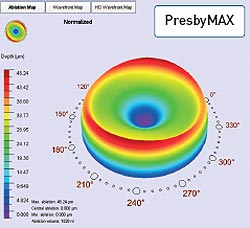Presbyopia is an accommodation disorder caused by a reduction in the elasticity of the crystal lens, which appears physiologically after the age of forty.
This results in a slow decrease in the ability of the eye to focus on objects nearby.
Presbyopia is a natural evolution of the aging process and affects everyone :
- Monovision and combined vision : Using PRK or Lasik surgery for myopia and hyperopia, and inducing a small degree of myopia on the dominated eye allows a comfortable close-up vision, while the dominating eye is corrected for far vision.
- Presby-Lasik : Lasik surgery that combines hyperopia correction for far vision and presbyopia for close vision on a second corneal focal. Visual outcome is usually 0.7 to 0.8 for far vision and 0.9 to 1.0 for close vision.
- PresbyMax : this is a treatment incorporated into the Schwind Amaris laser that allows computer-assisted treatment of presbyopia associated with myopia, hyperopia or astigmatism by creating a corneal multifocality that provides distance and near vision without correction. This technique is reversible in case of disturbing night-time visual disturbances.
PresbyMAX®:
This treatment module is ideal for the safe and effective treatment of patients with myopia, hyperopia, or astigmatism with presbyopia. PresbyMAX is based on a bi-aspheric and multifocal corneal ablation profile.

- Corneal Inlays Placement of an intra-corneal device in the non-dominant eye, allowing close vision without glasses by pinhole effect or focusing through a small hole (KAMRA technique) or by refractive effect. This technique is reversible by removing the device in case of intolerance or poor visual quality.
- PRELEX PRELEX (Presbyopic Lens exchange) is the extraction of the clear lens by phacoemulsification and its replacement by a multifocal, accommodative or EDOF lens, which enables far and near vision without correction. PRELEX's limitations and complications are identical to those of cataract surgery, although nocturnal halos and glare are possible in some cases. This technique is not reversible, and requires a complementary Excimer laser refractive surgery to correct residual ametropia in 5 to 10% of cases.
Multi-focal or accommodative artificial lens :


